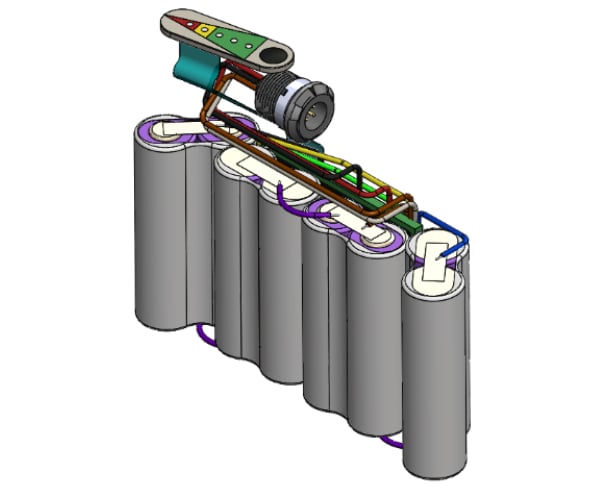Occasionally, customers have to change battery suppliers. There are many different reasons for these changes. It could involve the battery supplier going out of business, the customer may find a supplier that can offer similar batteries at lower prices and faster time-to-market deadlines, the quality of the battery could be lacking, or there is a disruption to the supply chain for the supplier that the customer must make a temporary switch to an optional manufacturer to complete project deadlines.
When providing a new custom battery pack design, working with a new supplier requires going through the basic design and manufacturing procedures. Yet, what if you have an existing design that the optional battery supplier will use? Will they be able to provide the same battery chemistry as a drop-in replacement? Will the components be the same, and will the battery packs have to go through recertification through the required organizations?
Here at Epec, we assist customers in getting over the hurdles and challenges when moving their battery pack design and manufacturing processes over to our processes. We will discuss what can occur when working with optional suppliers, some of the component and chemistry availability issues that may appear, and if certain components are standard designs throughout the battery manufacturing industry.
Using Optional Battery Suppliers for Drop-In Replacements
When having drawings created for the custom batteries that do not stray from the original schematics, finding an optional battery supplier is a simpler process. The more documentation and 3D designs that are available will give manufacturers a leg up in creating the battery packs that will meet the customer's specifications and the applications' power needs.

3D model of a custom battery pack with internal electronics and cells.
Also keep in mind that every manufacturer will have specific tooling, equipment, and capabilities present in their shops that could change how the battery chemistry is made, the circuitry that is used, and the materials that are placed into the housing. In addition, the new manufacturer may not obtain the exact same materials from the same supplier that the previous manufacturer used when creating the housing for the battery pack. While it might seem like these changes are minor, the material's characteristics could alter how they interact with the rest of the application.
Proof of concept validation should not be skipped over even when the optional battery supplier is using similar drawings to create the same battery that will be a drop-in replacement. Even though the design had been validated by the previous supplier, requesting sample batteries and prototypes from the optional battery supplier allows the customer to evaluate the quality of the battery pack while it is in the product before production runs are implemented. This strategy gives the customer a chance to take note of any differences that may be introduced into the design that could impact the application.
Cell and Component Availability
If the customer plans on changing battery suppliers, they need to fully examine the manufacturer’s supply chain capabilities and limitations. Not every supplier offers the same types of battery chemistry creations. Some manufacturers work specifically with nickel-based chemistries, while others have the certification to handle and transport lithium-based chemistries. The supplier may not have the tooling or equipment available to create the battery chemistry that is required.
Another factor that can be a challenge is the number of cells and components that are available. The battery supplier may offer the cell that the customer wants. But, since they don't take as many orders for those particular components, the supplier might not have all the materials on stock to create the desired batch quantity. This problem could lead the manufacturer to order more components as their supplier may have a quantity requirement where the manufacturer must order a certain number of components before the order is shipped out. This circumstance could lead to higher prices that will be passed onto the customer as they may have to order a minimum battery pack quantity from the supplier before production processes take place.
Another factor to take into consideration is where the cell and components may come from. Cell and component supply chains are global. Suppliers will be placing orders from other countries and regions that include China, Taiwan, and Malaysia. However, supply chain disruptions and the continuing U.S./China trade war can hinder where raw materials, parts, and components are obtained. This factor slows down order fulfillment and can impact a customer's time-to-market deadlines.
Evaluating the manufacturer's supply chain capabilities should go beyond examining whether they can deliver the finished battery packs and components from their production lines. Customers also need to understand where the cell and component materials are originating from and whether economic or market forces will create component supply issues that will impact the manufacturer's supply chains.
Battery Pack BMS Design Challenges
Certain battery chemistries, such as lithium-based batteries, require a battery management system (BMS) to ensure that the battery operates within safe parameters. Yet, there is no standard BMS design that all battery suppliers follow.
The reason there is no standard design is because each supplier will offer different features in their BMS offerings to remain competitive in the market. In addition, BMS components will be dependent on the types of chemistries that are developed for the battery. The main features that a BMS may offer include:
- Battery protection for charging/discharging
- State-of-charge and capacity (state of health) monitoring
- Cell balancing
- End-of-life threshold features
However, not every BMS device will provide all these functions. One supplier may design a BMS component that offers battery protection circuitry and state-of-charge monitoring, but not cell balancing. The type of features that will be offered should be analyzed by the customer to determine if the BMS system will work with the existing battery design, or if it will improve the battery pack's functionality and longevity.
Recertification Concerns When Using Optional Suppliers
Customers will spend enormous amounts of money to obtain certification for their battery pack designs. They have to offer a certain amount of battery samples that are required by the certifying agency to test. Yet, customers may be worried about switching suppliers because they believe that they will have to undergo recertification again with UL as well as DOT/UN38.3. Recertification may not be necessary depending on the battery chemistry and the designs.
If there are absolutely no changes to the battery design (for batteries that are not lithium based) when switching suppliers, then UL and DOT/UN38.3 recertification will not be required. This reason is because the battery pack and enclosure designs have already gone through the testing and validation phases. Yet, if there are even minor changes to the chemistry or other component designs, then recertification will have to be implemented again because the previous certification will not be valid.
If a customer is switching their supplier to obtain lithium-based packs, then DOT/UN38.3 recertification is required. This recertification also applies to new battery cells even when they are a direct replacement. The reason is that the cell approval cannot be transferred from one supplier to the next due to safety and transportation concerns. The safety confirmation was provided to the finished product, but not to the lithium battery's components.
Due to suppliers offering varying BMS designs and features, and that lithium-based batteries are required to have BMS components placed into the pack, the current design of the battery packs may differ significantly from the original designs. To ensure the safe handling and transportation of the lithium-based batteries, customers should be ready to undergo the recertification process again.
Summary
Switching between battery suppliers can be a stressful process. Costs and time-to-market deadlines may change significantly. Seek out a battery supplier that can work with you to ensure a smooth transition so that you fully understand how the manufacturing process will take place, what additional costs may be incurred, and will know when the battery packs will be delivered.
Key Takeaways
- Documentation helps simplify transitions: Detailed drawings, schematics, and 3D models make it easier for a new supplier to replicate an existing battery design, but proof-of-concept validation should always be performed before production.
- Supplier capabilities vary: Not all manufacturers can produce the same chemistries or maintain consistent supply chains for cells and components, which can affect cost, availability, and lead times.
- BMS designs differ by supplier: Battery management systems are not standardized, and features such as protection circuits, state-of-charge monitoring, or cell balancing may vary, requiring evaluation for compatibility with the existing design.
- Recertification may be required: Minor design or chemistry changes can trigger the need for recertification. Lithium-based packs always require new DOT/UN38.3 certification when switching suppliers.
- Supply chain risks must be assessed: Global sourcing challenges, including trade tensions and raw material shortages, can impact fulfillment, making it critical to evaluate a supplier’s full logistics and material sourcing processes.
















